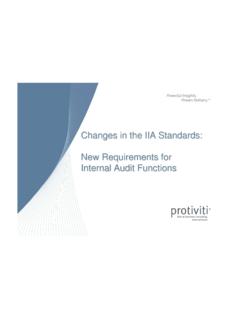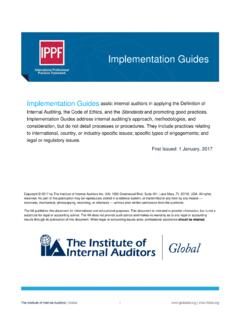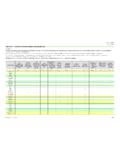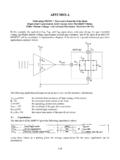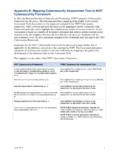Transcription of Appendix C - IIA
1 B-1 Executive Leadership & Operating ManagementC-1 Chief Audit ExecutiveC-3 IA StaffB-2 IA StaffC-2 Board Members, Senior & Operating ManagementC-4 External Auditors & Other Assurance ProvidersBackground Information and Document Request ChecklistEvaluation SummaryQuality Assessment ReportA1D1IA GovernanceIA StaffIA ManagementIA ProcessA2D2A4D4A3D3 Background Information on the internal audit (IA) Request Checklist cross-referenced to planning/program process flow: IA Governance, IA Staff, IA Management, and IA designed for each segment. Assessors document their conclusions regarding conformance with mandatory guidance here. Evaluation Summary provides a record of ratings determined within the programs by assessors. Quality Assessment Report formatted to meet the needs of key Guides designed for each segment.
2 Surveys containing elements from each segment. Interview Guides containing elements from each segment. QUALITY ASSESSMENT PROCESS MAPI nterviewsInterview GuidesC-1 AppendixCOv e r v i e wInterviews provide an opportunity to explore issues raised by the survey responses in more depth, address potential issues that are better covered in interviews, and allow interviewees to volunteer information and perspectives that may be valuable. In some cultures, people will be more honest in an interview than in a survey (and vice versa). Interviews with board members typically involve the chair and/or other audit committee members (or other body charged with oversight of the internal audit activity). Interviews with executive management typically involve the most senior executive and/or direct reports of the most senior executive, the executive to whom the chief audit executive (CAE) reports, and selected officers and operating managers.
3 These customer interviews elicit views on the value of audits and consulting engagements, client expectations, the professionalism of the audit staff, and areas for improving the internal audit activity (and other monitoring func-tions, as appropriate). They may also elicit views on the effectiveness of risk management, organizational controls and accountability, and other general management areas not strictly within the scope of the full external assessment, but potential issues for inclusion in the full external assessment interviews with the CAE and internal audit staff members may reveal different percep-tions of internal audit between the internal audit activity and its customers, or within the activity itself. Interviews with the internal audit activity s staff may include selecting at random staff that represent the various levels and locations of the activity and/or staff members who specifically requested interviews in their survey responses.
4 Another option to consider is the use of focus groups, particularly when the staff is many interviews to conduct and who to interview depend on factors such as the size of the organization, the accessibility of interviewees, and their level of involvement with internal audit. As a general rule, six or more interviews are needed to gather perspectives from the important stakeholder groups of the it is best to conduct these interviews at the beginning of the onsite visit, they may continue throughout the visit to accommodate the busy schedules of executive management. Tool A6: Interview Selection can be used to record relevant contact information for individ-uals asked to participate in Assessment Manual for the Internal Audit ActivityC-2in s t r u c t iO n s f O r us i n g t h e in t e r v i e w gu i d e sDuring the planning stage, the organization provides an organization chart from which the assessor selects individuals to interview.
5 The organization then schedules the interviews. Questions within the interview guides are organized into the four planning guides: A1: Internal Audit Governance, A2: Internal Audit Staff, A3: Internal Audit Management, and A4: Internal Audit Process. There are four interview guides: C1: Chief Audit Executive, C2: Board Members, Senior and Operating Management, C3: Internal Audit Activity Staff, and C4: External Auditors and Other Service guides should always be tailored to the situation. Before using one of the guides, review both the management and staff survey results for issues that can be explored in more depth during the interview and add questions if yourself with the background of each interviewee. Summarize any important background information under additional comments at the top of the guide.
6 Tailor the guide as needed for each interviewee. For example, if an interviewee is not in a position to know about a topic, delete it. This is particularly true for the management guide, because some of the questions will only be relevant for top management or the board, while others will be primarily for operating management. You might also want to reorganize questions to flow better with a given topics listed in bold must be addressed during the interview process, but not with every interviewee. Phrase questions on these topics as you like. Specific questions (in sub-numerals , , etc.) for each topic may be used to expand the interview or bring it back on track when responses are too general or do not address issues adequately. The number at the end of each topic (D1, D2, D3, and D4) refers to the related program.
7 If you add questions, attach one of these numbers to each question you add. At the end of the interview, you might want to ask, What question did you think I would ask, but didn t and how would you respond to that question? Appendix C Interview GuidesC-3 After the interview, list all of the key issues and leading practices you identified at the bottom of the interview form. Attach one of the numbers (D1, D2, D3, or D4) to each issue to facil-itate the flow of information gathered during the interviews into the overall Assessment Manual for the Internal Audit ActivityC-4

